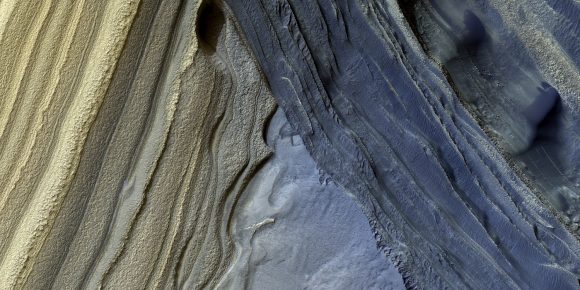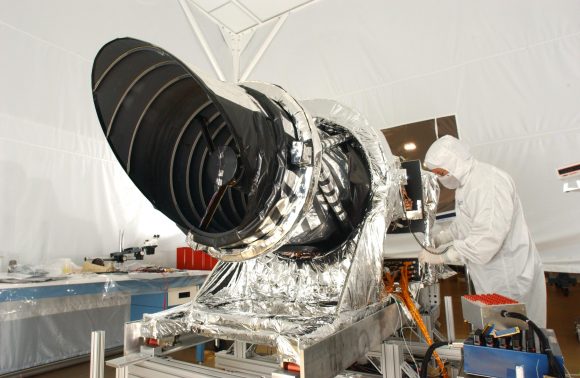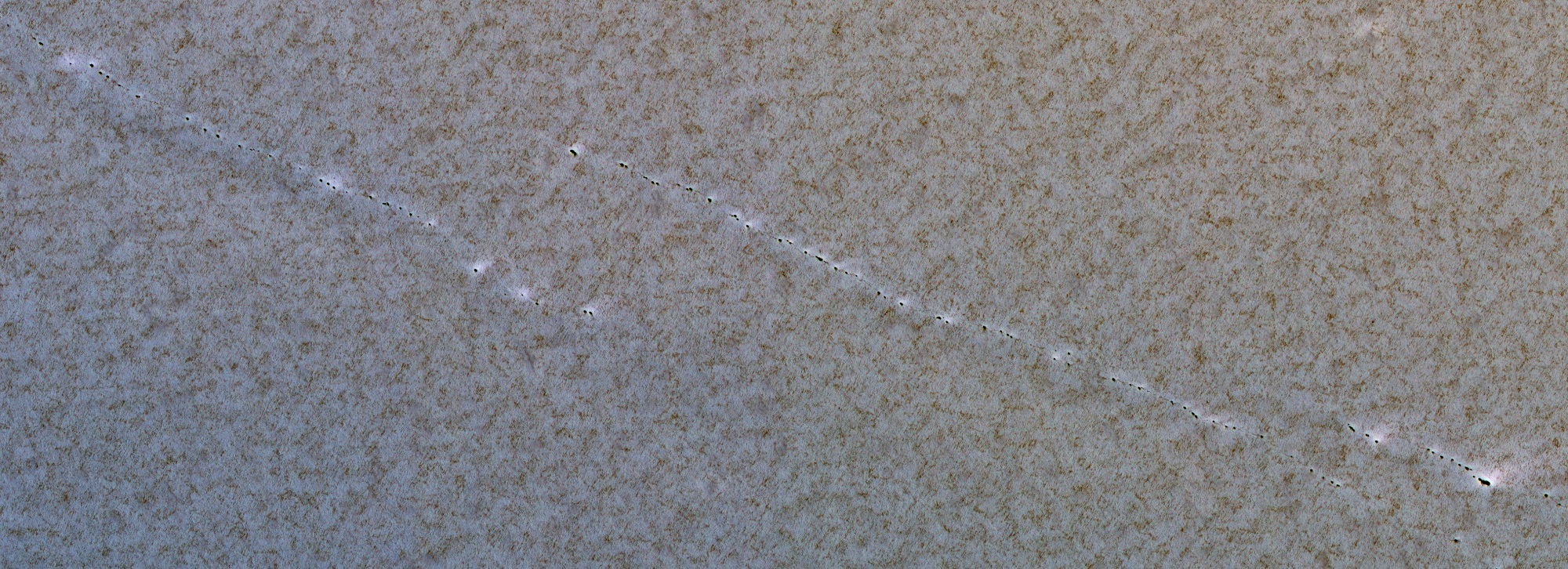Mars has many characteristics that put one in mind of Earth. Consider its polar ice caps, which are quite similar to the ones in the Arctic and Antarctic circle. But upon closer examination, Mars’ icy polar regions have numerous features that hint at some unusual processes. Consider the northern polar ice cap, which consists predominantly of frozen water ice, but also a seasonal veneer of frozen carbon dioxide (“dry ice”).
Here, ice is arranged in multicolored layers that are due to seasonal change and weather patterns. And as images taken by the Mars Global Surveyor and the Mars Reconnaissance Orbiter (MRO) have shown, the region is also covered in lines of small pits that measure about 1 meter (3.28 feet) in diameter. While these features have been known to scientists for some time, the process behind them remains something of a mystery.
Layered features around found both in the northern and southern polar regions of Mars, and are the result of seasonal melting and the deposition of ice and dust (from Martian dust storms). Both polar caps also show grooves which appear to be influenced by the amount of dust deposited. The more dust there is, the darker the surface of the grooved feature, which affects the level of seasonal melting that takes place.

These layered deposits measure around 3-kilometer thick and about 1000 kilometers across. And in many locations, erosion and melting has created scarps and troughs that expose the layering (shown above). However, as NASA’s Mars Global Surveyor revealed through a series of high-resolution images, the northern polar cap also has plenty of pits, cracks, small bumps and knobs that give it a strange, textured look.
These featured have also been imaged in detail by the High Resolution Imaging Science Experiment (HiRISE) instrument aboard the MRO. In 2008, it snapped the image shown at top, which illustrates how the layered features in the northern polar region also have lines of small pits cutting across them. Such small pits should be quickly filled in by seasonal ice and dust, so their existence has been something of a mystery.
What this process could be has been the preoccupation of researchers like Doctor Chris Okubo and Professor Alfred McEwen. In addition to being a planetary geologist from the Lunar and Planetary Laboratory (LPL) at Arizona State University, Prof. McEwen is the Principal Investigator of the High Resolution Imaging Science Experiment (HiRISE).
Dr. Chris Okubo, meanwhile, is a planetary engineer with the LPL who has spent some time examining Mars’ northern polar region, seeking to determine what geological process could account for them. Over time, he also noted that the pits appeared to be enlarging. As he explained to Universe Today via email:
“I monitored some of these pits during northern summer of Mars year 31 (2011-2012). The pits appeared to enlarge over time, starting from depressions roughly centered on the pits observed in in 2008. My interpretation is that these pits are depressions within the residual cap that formed through collapse above a fault or fracture. The pits are buried by seasonal ice in the winter, which then sublimates in the spring/summer leading to an apparent widening and exposure of the pits until they are reburied by seasonal ice in the subsequent winter.”

Since the MRO reached Mars in 2006, the LPL has been responsible for processing and interpreting images sent back by its HiRISE instrument. As for these pits, the theory that they are the result of faults pulling apart the icy layers is the most currently-favored one. Naturally, it will have to be tested as more data comes, in showing how seasonal changes play out in Mars’ northern polar region.
“I plan to re-monitor the same pits I looked at in MY31 during this upcoming northern summer to see if this pattern has changed substantially,” said Okubo. “Re-imaging these after several Mars years may also reveal changes to the size/distribution of the pits within the residual cap – if such changes are observed, then that would suggest that the underlying fractures are active.”
One thing is clear though; the layered appearance of Mars polar ice caps and its strange surface features are just another indication of the dynamic processes taking place on Mars. In addition to seasonal change, these interesting features are thought to be related to changes in Mars’ obliquity and axial tilt. Just one more way in which Mars and Earth are similar!
Further Reading: HIRISE

